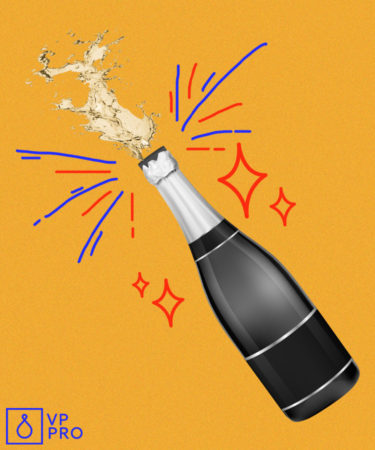This data is sourced from VinePair Audience Insights, which offers revolutionary real-time visibility into alcohol trends. Our indexes track the popularity of the 65 most important types of wine, beer, and spirits in the U.S. marketplace. Built upon the largest, proprietary collection of real-time first-party data about consumer alcohol preferences, VinePair Audience Insights empowers you to make smarter, faster marketing, purchase, and investment decisions. All data in this report is based on our inCategory Interest SubScores*.
We’re going to do things a bit differently with this month’s VinePair Audience Insights update. In conversations, over email, and following presentations, we’ve fielded a lot of questions about Champagne. The big question on everyone’s minds seems to be how to understand what our data is saying about Champagne’s performance year-to-date. So, we’re going to look back to the early days of lockdown, and then look forward, to explain how we see Champagne closing out the year.
First, some brief updates on other types of alcohol. In the world of spirits, we saw Bourbon (#1) jump +32% YoY to record its highest share of interest in almost three years. Rye (#9) was up +38% YoY to record its highest share in interest in over two years. And it wouldn’t be a 2020 spirits update without Cognac (#7) recording another tremendous month at +86% YoY.
Over in the world of wine Champagne (#1), while down a bit YoY, managed to reclaim the top spot, a position it hasn’t occupied since before the lockdowns. We’ll go deeper into this, but rank-wise, in our tracking set, Champagne is actually following the exact same pattern it did in 2019. The big winners in wine were Cabernet Sauvignon (#2) +77% YoY, Chardonnay (#4) +59% YoY, and Red Blends (#7) +74% YoY to its highest share of interest in the history of our tracking.
What’s different is how much ground Champagne has given up to the rest of the wine universe since March, while maintaining those ranks. What follows is an updated chart of data we presented last month. Instead of showing Champagne’s YoY change in interest, we’re presenting that data in a new way that you will hopefully find more intuitive and useful: the percent of interest Champagne maintained YoY.
Let’s look at what we’ve been saying about Champagne’s performance this year. We hope the information and chart above help square two diverging facts: 1) that Champagne has clawed back a lot of ground after a uniquely bad March and April; and 2) that consumers are still quite interested in Champagne, which you can see in the amount of dollars that shifted to off-premise. The first two updates were included in emails to VinePair partners and clients prior to the launch of VP Pro:
April 15 update:
Champagne posted an absolutely brutal March number. Interest was down 36% YoY, leading Champagne to post its lowest number in the history of our tracking series (since January 2017).
May 7 update:
Champagne followed up its brutal March number with a similar performance in April. Interest was down 38% YoY, leading Champagne to once again post its lowest number in the history of our tracking series (since January 2017).
VP Pro’s Lookback at May:
Champagne, though down moderately YoY (-9%), was also up 27% over April. We believe it is far too early to say whether a bottom has been hit though, marking the start of a sustained recovery in interest.
VP Pro’s Lookback at July via The Takeaway:
#2 Champagne posted an even smaller YoY decline than last month (-1% vs. -3%). While it would seem like Champagne’s decline has by now hit bottom, the economic uncertainty over the expiration of enhanced unemployment insurance benefits, PPP money coming to an end for many businesses, and the continued spread of Covid-19 make forecasting for such a celebration-linked beverage extremely tricky.
VP Pro’s Lookback at August via The Takeaway:
Champagne (#2) and Prosecco (#3) were fairly flat in August. Champagne again posted sequential gains, clocking its highest monthly level of interest post-Covid lockdown in August.
VP Pro’s Lookback at September via The Takeaway:
Interest in Champagne continues to stabilize after sharp drops in the early days of Covid-19 lockdowns. The only thing we see possibly standing in front of Cabernet making big gains in its traditionally stronger months of fall and winter is election-related uncertainty. Will consumers flock to Champagne to celebrate their favored outcome? Or substitute stronger spirits if political chaos persists well past election day? (Interestingly, according to recent survey data, Democrats skew toward Champagne; while Republicans oversample for Cabernet Sauvignon.)
This brings us to the final eight weeks of the year. On Monday, Drizly released some early data around the election, finding that: “Sparkling Wine and Champagne” was the top-selling wine subcategory on Saturday, moving ahead of red and white wine share. Sparkling Wine and Champagne accounted for 44.33% of wine sales compared to 20.98% average of the previous 4 Saturdays. (excluding Halloween).”
This early data from Drizly largely squares with VinePair’s real-time tracking (which does not include the full set of data included in the VinePair Audience Insights indexes, but is a very useful indicator).
We expect Champagne to climb to the top wine spot this month, and in December. If it doesn’t, it will likely be due to Cabernet Sauvignon — the first time in our tracking the latter claims the top spot.
* inCategory Interest SubScores measure relative audience interest for a given type of wine, beer, or spirit against its peers within its category. Click to learn more about VinePair Audience Insights.
This story is a part of VP Pro, our free content platform and newsletter for the drinks industry, covering wine, beer, and liquor — and beyond. Sign up for VP Pro now!

